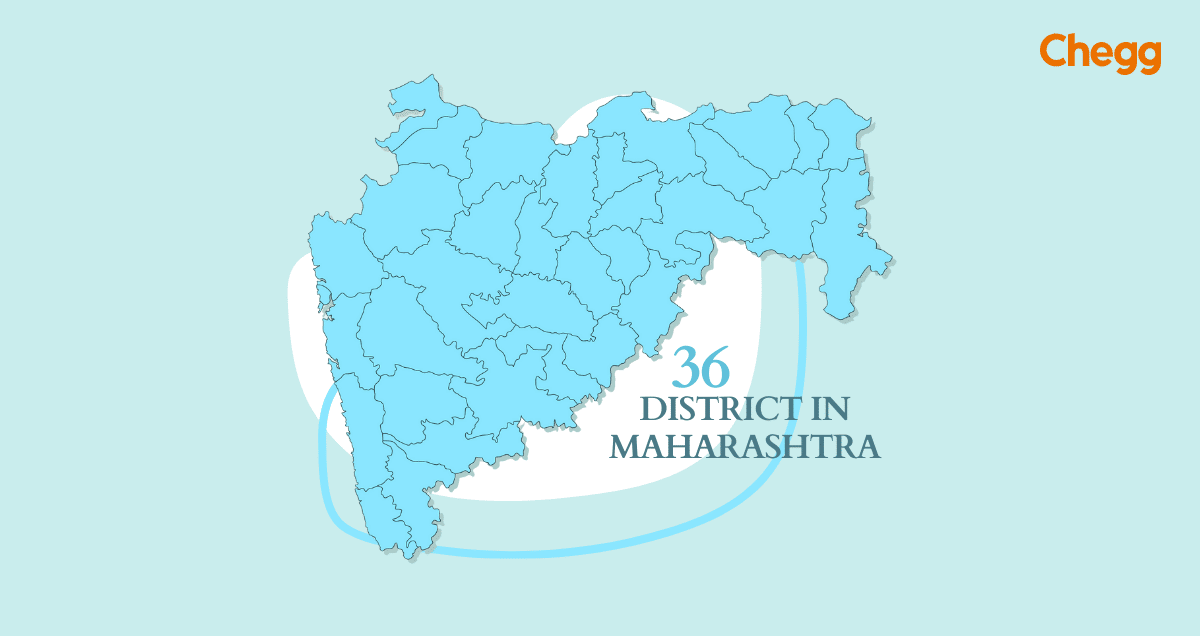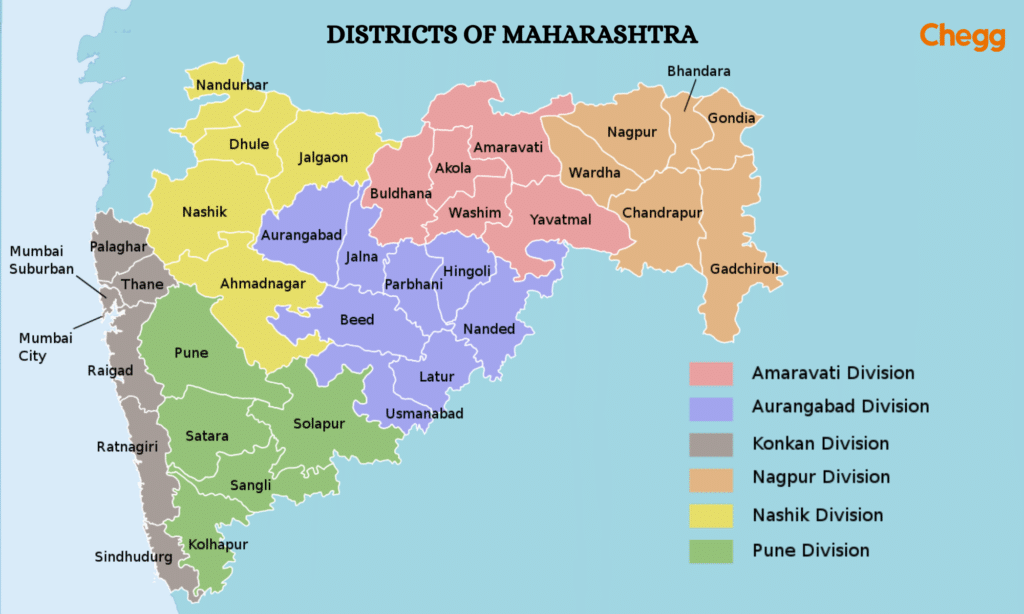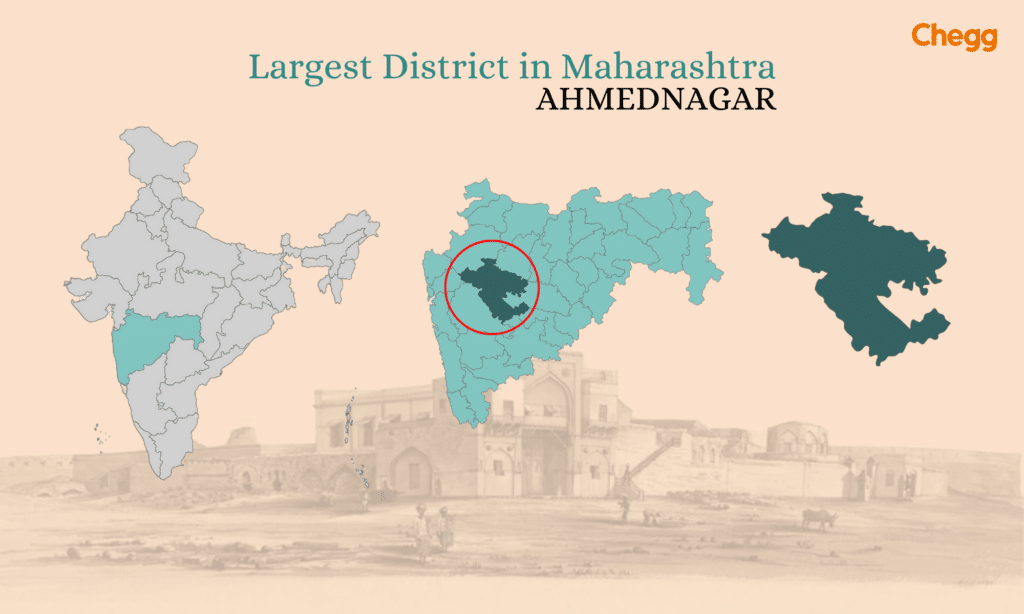Home » General Knowledge » How Many Districts in Maharashtra?
How Many Districts in Maharashtra?

Table of Contents
Overview of Maharashtra Administrative Structure
Maharashtra, a big state in India, is divided into 36 districts. Think of districts like puzzle pieces that make up the state. Each district has a leader called a district collector who looks after things in that area. These districts are then divided into smaller parts like talukas, villages, and towns. This setup helps the government run things smoothly, make sure everyone is safe, and deliver services to people who live in these areas.
Exploring Maharashtra
1. Historical Origins
Maharashtra, which means “The Great State,” officially came into existence on May 1, 1960. But its story reaches far back in time. The land has seen the rise and fall of ancient empires like the Mauryas, Satavahanas, Chalukyas, and the mighty Marathas. Chhatrapati Shivaji, a legendary figure, led the Maratha Empire, leaving a lasting legacy. This rich history is a vital part of Maharashtra’s identity.
2. Geographical Diversity
Maharashtra’s diverse landscapes make it a fascinating state, blending natural beauty with vibrant urban life. From the iconic skyline of Mumbai to the serene hills, it offers a rich tapestry of experiences. Anything specific you’d like to know or discuss about Maharashtra? This diversity contributes to its vibrant agriculture and unique landscapes.
3. The Western Ghats
One of Maharashtra’s treasures is the Western Ghats, a mountain range adorned with lush greenery and breathtaking vistas. These hills are a haven for biodiversity, housing numerous rare and exotic plant and animal species. It’s a paradise for trekkers and nature lovers, offering serene escapes from the hustle and bustle of city life.
4. Urban Hubs
On the other hand, Maharashtra boasts vibrant urban centres like Mumbai and Pune. Mumbai, often called the “City of Dreams,” is India’s financial and entertainment capital. It’s a melting pot of cultures and opportunities, with a bustling film industry and a dynamic lifestyle. Pune, known for its educational institutions, is a hub of innovation and technology.
5. Vidarbha’s Arid Landscapes
Vidarbha, in the eastern part of Maharashtra, offers a striking contrast with its arid landscapes. This region faces unique challenges due to its semi-arid climate, making it a significant agricultural area. Farmers in Vidarbha are skilled in techniques for cultivating crops in these conditions, contributing to the state’s agricultural richness.
6. Agricultural Wealth
Maharashtra’s diverse landscapes support a wide variety of agricultural practices, from the cultivation of rice and sugarcane in its fertile plains to the growth of grapes and oranges in its hilly regions. The state significantly contributes to India’s agricultural output, making it a crucial part of its food production.
Hence, Maharashtra is a land of incredible contrasts. Its blend of nature and urban life, from the Western Ghats to bustling cities and arid regions, not only makes it an exciting place to explore but also a vital part of India’s cultural and economic tapestry. This state truly encapsulates the essence of India’s diversity and its ability to thrive in various environments.
7. Economic Powerhouse
Maharashtra is like India’s economic engine. It chips in 14 percent of India’s total economic output, officially called Gross Domestic Product (GDP). This economic strength comes from its prime location, robust industries, major business hubs like Mumbai, and a thriving services sector. Some people even call Mumbai the financial capital of India!
8. Historical Treasures: The Forts
Here’s a fun fact – Maharashtra is home to around 350 forts! Each of these forts has stories to tell. They’re like time machines taking us back to different times and battles. Raigad, Sinhagad, and Pratapgad are some of the famous ones. These forts aren’t just old walls; they’re windows to the past.
In a nutshell, Maharashtra is a land of history, diverse landscapes, economic strength, and an abundance of forts. It continues to play a crucial role in India’s growth and has a rich cultural tapestry that’s worth exploring.
Total District in Maharashtra
Marathwada Division is one of the six administrative divisions of the Indian state of Maharashtra. It is located in the southeastern part of the state and is known for its historical and cultural significance. Here are the districts in the Marathwada Division, along with their respective division capitals:
| Division (Marathwada) | Division Capital | Districts Included |
| Aurangabad Division | Aurangabad | |
| Latur Division | Latur | |
| Beed Division | Beed | Beed District |
| Nanded Division | Nanded | |
| Hingoli Division | Hingoli | Hingoli District |
| Parbhani Division | Parbhani | Parbhani District |
Maharashtra District List
Here is a list of districts in the state of Maharashtra, along with their populations, in a table format:
| District | Population |
| Mumbai City | 3,085,411 |
| Mumbai Suburban | 9,356,962 |
| Thane | 8,070,032 |
| Palghar | 2,990,116 |
| Raigad | 2,634,200 |
| Ratnagiri | 1,615,069 |
| Sindhudurg | 849,651 |
| Ahmednagar | 4,543,159 |
| Dhule | 2,050,862 |
| Jalgaon | 4,229,917 |
| Nandurbar | 1,648,295 |
| Nashik | 6,107,187 |
| Bhandara | 2,585,049 |
| Chandrapur | 2,204,307 |
| Gadchiroli | 1,072,942 |
| Gondia | 1,322,507 |
| Nagpur | 4,653,570 |
| Wardha | 1,300,774 |
| Aurangabad | 3,701,2821 |
| Beed | 1,200,234 |
| Jalna | 1,959,046 |
| Osmanabad | 1,657,576 |
| Nanded | 3,361,292 |
| Latur | 2,454,196 |
| Parbhani | 1,836,086 |
| Hingoli | 1,177,345 |
| Akola | 1,813,906 |
| Amravati | 2,888,445 |
| Buldhana | 2,586,258 |
| Yavatmal | 2,772,348 |
| Washim | 1,197,160 |
| Sangli | 2,822,143 |
| Satara | 3,003,741 |
| Solapur | 4,317,756 |
| Kolhapur | 3,876,001 |
| Pune | 9,429,408 |

Smallest District in Maharashtra
Mumbai City District, nestled within the Konkan division of Maharashtra, is recognized as the smallest district in the state. It covers a mere 157 square kilometers. Despite its modest geographical size, this district carries immense significance due to its central role as the home to Mumbai, which serves as the financial hub of India. As of the year 2023, Mumbai’s population has swelled to approximately 21,297,000 residents, marking a 1.6% increase from the preceding year. The district’s compact dimensions belie the extraordinary population it supports. Mumbai City District is celebrated for its pivotal contributions to India’s financial sector, housing prominent stock exchanges and corporate headquarters. Additionally, it boasts a thriving cultural and entertainment industry, epitomized by Bollywood, the Indian film industry. The district also preserves a rich historical and architectural heritage, featuring landmarks such as the Gateway of India and the Chhatrapati Shivaji Terminus.
In summary, the Mumbai City District, despite its small expanse, exerts a monumental influence on the socio-economic fabric of Maharashtra and the nation as a whole. Its status as a vital financial and cultural epicenter, coupled with its sizable population, elevates it to an exceptional and iconic district in Maharashtra.

Largest District in Maharashtra: Ahmednagar
Ahmednagar, the largest district in Maharashtra, is a land of great historical and cultural significance. With an expansive area of 17,048 square kilometers, it is celebrated for its diverse attributes and unique features. One of the most well-known aspects of Ahmednagar is its spiritual prominence. The district is home to the renowned Shirdi Sai Baba Temple, a site of immense religious devotion and one of the most visited pilgrimage destinations in India. Pilgrims and tourists from all over the country and the world flock to this sacred place to seek blessings and solace. Beyond its spiritual allure, Ahmednagar boasts a rich historical legacy dating back to the Maratha Empire. The district has forts, monuments, and historical sites, each narrating a chapter of its storied past. Explorers and history enthusiasts will find ample opportunities to explore the region’s heritage. Hence, Ahmednagar is the largest district in Maharashtra, celebrated for its spiritual sanctity, historical treasures, and agricultural prosperity. It encapsulates the essence of Maharashtra’s diversity and heritage.

Also Read:-
How Many Districts in Karnataka? | An Overview
How Many Districts in West Bengal? Brief Overview
How Many Districts in India: State Wise List of Districts
New Districts in Maharashtra
Maharashtra, a state known for its diverse landscape and growing population, is considering the formation of new districts to facilitate governance and better administration. Here’s the list of new districts in Maharashtra, along with a few details about each:
- Nashik District (from Malegaon and Kalwan): The proposed Nashik District will emerge from parts of Malegaon and Kalwan.
- Thane District (from Mira-Bhainder and Kalyan): Thane, an important district in Maharashtra, is set to expand further by adding areas from Mira-Bhainder and Kalyan.
- Buldana District (from Khamgaon): Buldana, a proposed district, will encompass regions currently part of Khamgaon. This area is notable for its agricultural activities and cotton production.
- Achalpur District (from Amravati district): Achalpur, a proposed district, would form from Amravati. Amravati itself is known for its educational institutions and cultural heritage.
- Sakoli District (from Bhandara district): Sakoli will be a new district extracted from Bhandara. This region is rich in natural resources and forestry.
- Chimur District (from Chandrapur district): Chimur is proposed to be separated from Chandrapur. Chandrapur is known for its coal mines and wildlife sanctuaries.
- Aheri District (from Gadchiroli district): Aheri would be created from Gadchiroli. This region is a significant part of Maharashtra’s tribal belt.
- Bhusawal District (from Jalgaon district)**: Bhusawal, formed from Jalgaon, is an important agricultural and industrial hub in Maharashtra.
- Udgir District (from Latur district): Udgir aims to become independent by separating itself from Latur. Latur is known for its historical and cultural heritage.
- Ambejogai District (from Beed district): Ambejogai, carved out of Beed, is a region with religious and historical significance.
- Kinwat District (from Nanded district): Kinwat as a district would be separated from Nanded, which has a rich historical background.
- Mandesh District (from Satara district): Mandesh aims to be a new district within Satara, a region famous for its strawberries and cultural heritage.
Conclusion
In conclusion, the districts of Maharashtra offer a vibrant mosaic of culture, history, and diversity. From the bustling metropolis of Mumbai to the serene villages of the Konkan coast, each district has its unique character and significance. Maharashtra’s districts are more than just administrative units; they are repositories of heritage, economic vitality, and geographic splendor. From the largest district of Ahmednagar, with its religious significance and agricultural productivity, to the proposed new districts set to enhance the state’s administrative efficiency further, Maharashtra’s district landscape is a dynamic reflection of a state that balances tradition and progress.
Got a question on this topic?